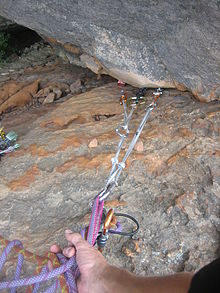


A sling is an item of climbing equipment consisting of a tied or sewn loop of webbing. These can be wrapped around sections of rock, hitched to other pieces of equipment, or tied directly to a tensioned line using a Prusik style knot. They may be used as anchors, to extend an anchor to reduce rope drag, in anchor equalization, or to climb a rope.
Uses
In 1957 Jan and Herb Conn wrote an article titled "the versatile runner" with a long list of uses, which is still quite accurate:
- Slings and now more often 3-foot alpine draws or shorter quickdraws are used in-between pieces of protection and the rope to minimize rope drag
- Hitch around a chock stone or a tree to use as passive protection
- Clove hitch around chicken heads or sling around horns
- Longer slings or cordelettes can be used for equalized belay stations
- Slings can be used as improvised "personal anchor system" attaching climber directly to anchors
- Slings can be used as improvised retreat anchor used in mountaineering or alpine environment, to prevent leaving behind more expensive equipment
Other possible uses include:
- as improvised gear sling
- as improvised etrier or aider
- they are also very useful in clean rope management
Types
Slings come both sewn to length and assembled from loose webbing knotted as desired. Common sewn lengths include 10 centimetres (3.9 in), 30 centimetres (12 in), 60 centimetres (24 in), 120 centimetres (47 in) and 240 centimetres (94 in). They are available in widths of 6–20 millimetres (0.24–0.79 in). Webbing for slings, also known as tape, is sold off the reel, cut to length with a hot knife to prevent fraying, and tied. The most common knot used for nylon slings are water knots and double fisherman's knots. Dyneema/Spectra slings are usually sewn not tied due to very high lubricity which leads to poor knot-holding ability and has led to the recommendation to use the triple fisherman's knot rather than the traditional double fisherman
Sewn slings have a rated breaking strength of at least 22 kilonewtons (4,900 lbf). Short sewn slings are a component of quickdraws, sometimes known as dogbones. Traditionally, slings have been made of nylon. Increasingly, ultra high molecular weight polyethylene sold under the brand names Dyneema, Dynex and Spectra is used. These have much lower melting points than nylon, making them a potentially poor choice where high rope friction may occur. However this specialty polyethylene is lighter, smaller, and absorbs less water than nylon, and therefore has become popular.
Gear sling
A gear sling is a loop of webbing used to organize or carry equipment. These can be custom items meant only to carry light gear, fully load-bearing manufactured gear racks capable of doubling for a sling, or simply a regular sling used to rack gear.
See also
References
- Cox, Steven M.; Kris Fulsaas, eds. (September 2003). Mountaineering: The Freedom of the Hills (7 ed.). Seattle: The Mountaineers. ISBN 0-89886-828-9.
- ^ Conn, Jan and Herb (November 1957). The versatile runner - Summit (PDF)
- Tom Moyer, Paul Tusting, Chris Harmston,(2000) Comparative Testing of High Strength Cord.